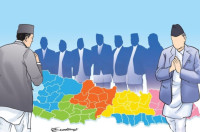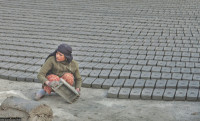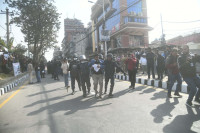Opinion
Relief under water
South Asian countries need to join forces to effectively fight the aftermath of natural hazards
Zulfiqar Shah
It was in 2010 that a great flood in South Asia inundated plains and valleys on both sides of the Indus River. We took initiatives to give maximum relief to the population hit by the disaster in the Sindh and Balochistan provinces in Pakistan, which was our intervention area as civil society actors. On our request, Kanak Mani Dixit together with the South Asian Trust based in Nepal established the Indus Flood Relief Fund in Kathmandu. We were also supported by other South Asians as well as by the American Jewish World Service.
Unfortunately, all our efforts in Sindh and Balochistan encountered resistance by the establishment, which not only had problems with the initiatives taken by the Sindhi society for their people’s humanitarian support during a disaster, but with our reaching out outside Pakistan without the nod of the Pakistani establishment. Now, floods have hit Pakistan again, worsening the lives of those who live in central and southern Punjab and in Sindh.
Dubious measures
In 2010, the civil and military establishment in the centre was trying their best to reduce the number of flood victims in Sindh in reports and data they shared with the international humanitarian community. Besides, they diverted floodwaters to save a maximum of military installations in Sindh at the cost of people and even inundated some areas deliberately for ‘strategic reasons’. This resulted in an actual increase in the number of flood affected people and Internally Displaced People (IDP) by nearly ten million according to the Sindh Government and by around seven million according to the Islamabad based ethnically monotonous National Disaster Management Committee (NDMC).
The great flood of the Indus River in 2010 re-wrote the socio-economic and political history of the Sindhi people. The worst ever shock received by the people of Sindh was, when a Karachi based ethnic-political party, claiming to represent the Urdu speaking refugees who migrated to Sindh after 1947, practically resisted temporary migration of the flood affected Sindhi to Karachi despite the fact that a large part of the Indus plains in Sindh was under water.
There was yet another rainfall-induced flooding in 2011, but lower in scale than the previous, inundating only the Sindh province. NDMC, a government body authorised to communicate with the international donor agencies and the UN for disaster relief activities, neither took the initiative for relief operations nor did it ask the international funding community for humanitarian intervention in Sindh.
Inexcusable delay
In a workshop organised by Oxfam GB in Islamabad in 2011, civil-society representatives from various parts of Pakistan sat along with the international humanitarian community. As a participant in the workshop I seized the opportunity to ask Timo Pakkala, UN Country Representative in Pakistan, about the reasons behind their unexpected delay of nearly two months in taking an initiative for relief and rehabilitation activities, during which hundreds died and hundreds of thousands became homeless and had to live under the open sky. He replied that the UN actually could intervene without seeking the nod from Pakistan authorities; however due to various reasons they had waited for the Pakistani authorities’ request. I confronted others with the same question, among whom was a representative of Church World Service (CWS), a Westerner. He told the participants that when he actively contacted the authorities in Islamabad and told them that CWS was willing to undertake relief activities in Sindh. But a bureaucrat told him that his keenness for relief activities indicated that he was a sympathiser of the Jeay Sindh (a term used in Pakistan for Sindhi secessionists). Thus, CWS also kept away.
Indian newspapers these days publish a lot of news about the Indian Army’s and Air Force’s rescue operations in the flood hit state of Jammu and Kashmir. The Indian Prime Minister Narendra Modi has also gracefully written to his Pakistani counterpart Nawaz Sharif that India would agree to undertake relief and rescue operations in Pakistan held Kashmir. In 2006, India had no doubt delivered great relief to the Pakistani side of Kashmir during the earthquake that affected almost the whole of Pakistan’s North.
This again reminds me of the Indus Floods in 2010 and the Sindh Floods in 2011. In 2010, Pakistani armed forces, at one point, stopped the rescue operations and asked the Sindh Government to clear the bills for those operations that included the cost of boats, helicopters and vehicle utilisation as well as the services of the Army. In 2011, the armed forces did not even move to undertake rescue operations in Sindh. That’s why, when I said emotionally at a forum, that if our Army could not help the people of Sindh we would be justified to request troops from the Indian authorities to rescue our people. This led to a visit of Pakistani military officials to our office by late 2011. It started with a hot tempered exchange of words, suddenly turning into threats directed at us. Due to our stance as civil, political and minority rights activists we were left with no other option than to close down The Institute for Social Movement, Pakistan and seek refuge out of the country.
Join forces
Gushing waters of five rivers of Punjab and the mighty Indus have again inundated Punjab and Sindh recently. Pakistani newspapers again have been telling the same old stories about IDPs as well as inundations of human settlements as a side-effect of efforts to save the military installations. The situation is bound to create another humanitarian crisis. This time, civil actors seeking to support flood affected people, the Pakistani authorities, the world humanitarian’s community and the United Nations Office for the Coordination of Humanitarian Affairs (UN-OCHA) need to be both wise and bold to avoid repeating past blunders.
At the same time, the South Asian countries need to establish a South Asian Humanitarian Fund as well as a mechanism to jointly fight the aftermaths of natural disasters. In this regard, India, being the leading country of South Asia, together with Nepal, being a virtual capital of South Asian initiatives, can do a lot by brinding all the other countries of the region together for such a noble cause. Would Saarc kindly stand up and show that it is not only a forum of South Asian states, but one of and for the South Asian people as well?
Shah is a Sindhi refugee journalist, activist and analyst




 9.12°C Kathmandu
9.12°C Kathmandu










